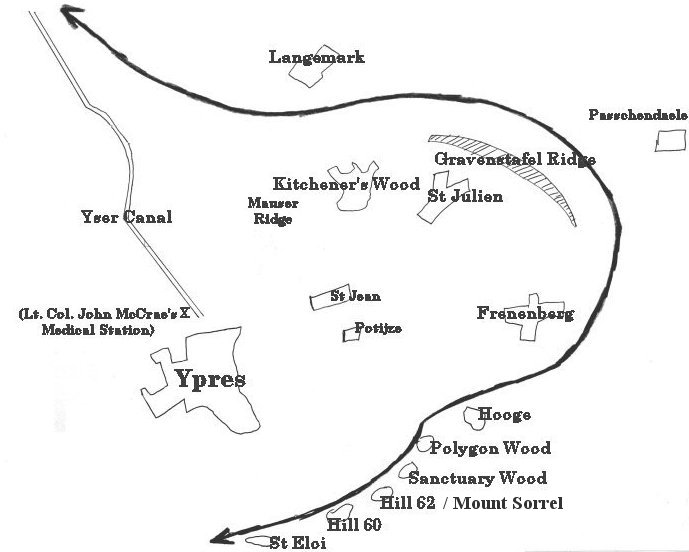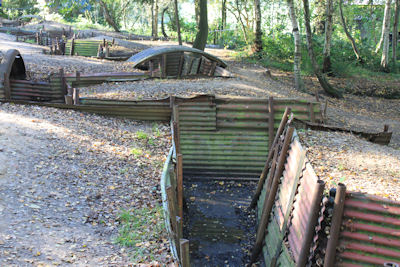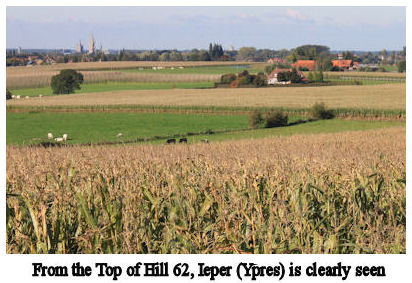Sanctuary Wood,
Mount Sorrel & Hill 62
June 1916
During the Second Battle of Ypres, the Canadians had been "baptized" into
the war. By June of 1916 Canada's Third Division had been ordered to take
over the positions on the opposite side of the Ypres Salient: Mount Sorrel,
Sanctuary Wood and Hill 62. These positions were a rare bit of high ground
under allied control in the sector. It is also important to realize that the
Canadian positions were relatively unsupported as the British had stripped
down the sector to prepare for their July 1, 1916 offensive on the Somme.
For the most part, the Canadians were somewhat alone with the important
exception of British artillery support.

The fact that these positions were in fact on high ground made them of
particular interest for the German forces. Taking this ground would place
the entire section of the Ypres Salient open to enemy fire and destabilize
the allied positions. The German attack on the Canadian positions came on
June 2, 1916. The combination of a vicious artillery assault linked with the detonation of 4 large mines under Mount Sorrel proved to be
devastating for the Canadians soldiers. The deadly effect on the trench
lines was total. The 4th Canadian Mounted Rifles had casualties of all but
76 of their original 702 men. Once again, Canada's Princess Patricia's
Canadian Light Infantry had found themselves in harm's way with losses of
almost 400 men at Sanctuary Wood. Over the next four days, the Canadians
would be halted in the immediate attempts to retake the positions and suffer
further casualties when the Germans moved their attack to nearby Hooge,
where four more nines were exploded under the Canadian trench line.
detonation of 4 large mines under Mount Sorrel proved to be
devastating for the Canadians soldiers. The deadly effect on the trench
lines was total. The 4th Canadian Mounted Rifles had casualties of all but
76 of their original 702 men. Once again, Canada's Princess Patricia's
Canadian Light Infantry had found themselves in harm's way with losses of
almost 400 men at Sanctuary Wood. Over the next four days, the Canadians
would be halted in the immediate attempts to retake the positions and suffer
further casualties when the Germans moved their attack to nearby Hooge,
where four more nines were exploded under the Canadian trench line.
I think at this point, it is important to point out that the situation
looked extremely bleak except for the, soon to be realized, factor of
brilliant leadership and unbelievable bravery of the troops. Julian Byng had
just been placed in command of the Canadians forces and he along with Arthur
Currie took on the task of preparing the men and forming the plan to save
the position and in some respects, save the honour of the Canadian forces.
In a method that would foreshadow successes at Vimy Ridge almost a year
later, Byng and Currie worked to train the men to be familiar with the
geography of the area. Each man would know where he was going and what was
expected of him as the day wore on. Should an officer fall, there would be
no interruption of the plan, as the men were very aware of their duties.
Artillery would be used in a new fashion. Rather than the predictable
approach of sending the ground attack "over the top" immediately after the
artillery barrage, the Canadians began & ceased the artillery 4 times. At
the end of each barrage the Germans (following normal procedure) would man
their guns and prepare for the attack that did not come. By the time the
Canadians actually attacked, the German defenders had lost their edge and
were thrown off their normal routines. The Germans were also forced to
endure high casualties on the resumption of the artillery, as their men were
at their stations - in the open - and not prepared for another round of
artillery shells.
The Canadians had planned a night attack. At 1:30 am, after another round of
artillery, the Canadian forces attacked. The positions lost initially on
June 4 were retaken. The victory was not without a serious toll: 8,430
casualties. Once again, the German army would learn the bitter lesson that
the Canadians would not be pushed back. Innovative tactics would change the
face of the Canadian approach to war.


